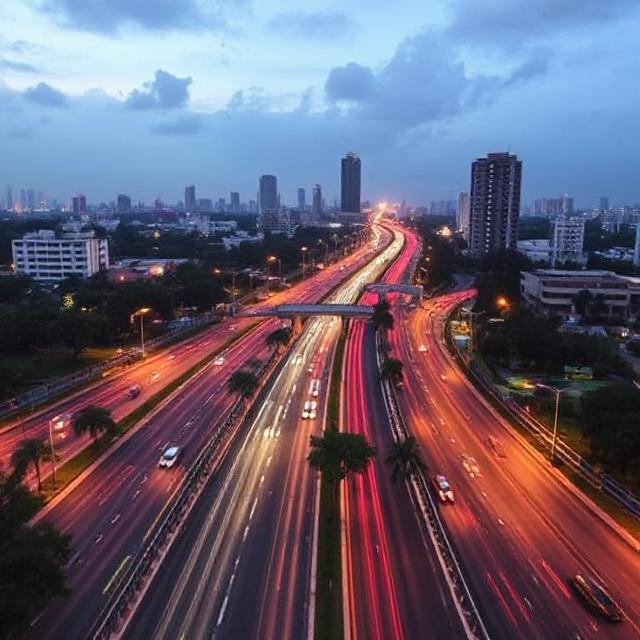Bengaluru Business Corridor: Karnataka’s 117 Km Game-Changer for Urban Mobility
1. Introduction: Bengaluru’s Next Leap in Urban Infrastructure
Bengaluru — India’s Silicon Valley — is growing faster than its roads can handle. With over 1.4 crore residents, 14 lakh registered vehicles, and a growing suburban sprawl, traffic congestion has become the city’s biggest bottleneck to productivity and quality of life.
To tackle this head-on, the Karnataka government has approved the long-awaited 117-km Bengaluru Business Corridor, earlier known as the Peripheral Ring Road (PRR).
This landmark project aims to cut intra-city traffic by 40%, offering a new outer transport loop that connects major highways, industrial zones, and IT corridors around Bengaluru.
🚧 Project Length: 117 km
🛣 Structure: 8-lane tolled expressway + 2 service lanes (each side)
🚲 Extras: Dedicated bicycle lane + 10-ft footpath
🕒 Completion Timeline: 2 years
🌾 Land Acquisition: ~2,560 acres from 4,000 farmers
This corridor isn’t just a road — it’s a new economic artery designed to boost industrial growth, reduce commute times, and modernize Bengaluru’s logistics movement.
2. What Is the Bengaluru Business Corridor (BBC)?
The Bengaluru Business Corridor (BBC), earlier called the Peripheral Ring Road (PRR), is a 117 km circular expressway proposed around the outer edges of Bengaluru city.
It’s designed to connect all major national highways (NHs) and state highways (SHs) passing through Bengaluru, providing an alternative bypass for through-traffic and heavy vehicles that currently choke the city’s arterial roads.
Key Design Highlights
- 8 main lanes of high-speed tolled traffic
- 4 additional service lanes (2 on each side) for local access
- Dedicated bicycle track to promote sustainable commuting
- 10-ft wide pedestrian footpaths alongside both service roads
- Green buffer zones and sound barriers in urban stretches
The corridor is being developed as part of Karnataka’s integrated urban mobility mission, aligning with Bengaluru Vision 2030 and Atmanirbhar Bharat infrastructure goals.
3. Why the Bengaluru Business Corridor Matters
3.1 Cutting Traffic Congestion by 40%
According to the Bengaluru Development Authority (BDA) and Karnataka Urban Infrastructure Department, nearly 40% of the current city traffic is through-traffic — vehicles that do not have a destination within the city limits.
The Bengaluru Business Corridor will divert heavy vehicles and cross-city traffic away from core areas, easing pressure on key roads such as:
- Outer Ring Road (ORR)
- Tumakuru Road
- Hosur Road
- Old Madras Road
- Mysuru Road
3.2 Boost to Economic Growth
The corridor is expected to spur commercial, industrial, and residential development along its route, creating special economic zones (SEZs) and logistics hubs.
It will connect major industrial clusters like:
- Peenya Industrial Area
- Electronics City
- Devanahalli Aerospace SEZ
- Whitefield IT Hub
- Dabaspet and Tumakuru industrial zones
3.3 Time and Fuel Savings
Current east-west or north-south trips through Bengaluru can take 2–3 hours. The new corridor is expected to cut this to under 45 minutes, saving time, fuel, and vehicle maintenance costs.
4. How the Bengaluru Business Corridor Will Be Built
4.1 Project Phases
The 117 km stretch will be divided into three major packages, enabling parallel construction:
- North-West Segment: Tumakuru Road to Hosur Road
- South-East Segment: Hosur Road to Old Madras Road
- East-North Segment: Old Madras Road to Tumakuru Road
Each phase will include grade separators, flyovers, and interchanges for seamless traffic flow.
4.2 Timeline
The Karnataka government has set an ambitious two-year completion target once all clearances and financial closures are completed.
- 2025: Land acquisition and design approvals
- 2026: Civil works initiation
- 2027: Phased opening and toll operations
5. Land Acquisition and Farmer Compensation
Land acquisition has been the most contentious part of the project since its first proposal nearly 15 years ago. However, the government now reports substantial progress.
5.1 Area and Ownership
- Total land required: ~2,560 acres
- Number of farmers affected: ~4,000
- Area covered: North Bengaluru (Hesaraghatta, Devanahalli), East (Bidarahalli), and South (Kanakapura and Hosur Road belts)
5.2 Compensation Options
The state has offered multiple compensation models:
- Monetary Compensation — as per latest market rates
- Land-for-Land in developed layouts nearby
- Transferable Development Rights (TDR) for equivalent land value
This hybrid model ensures minimal displacement while allowing farmers to benefit from rising land values along the corridor.
6. Infrastructure Features of the Corridor
6.1 Multi-Layered Mobility
Each stretch will incorporate dedicated mobility layers:
- Expressway lanes for long-distance vehicles
- Service lanes for local commuters
- Cycle tracks and footpaths for non-motorized traffic
6.2 Smart Tolling and ITS
The project will feature RFID-based smart tolling, real-time traffic sensors, and CCTV surveillance for safety and monitoring.
Integration with FASTag and NHAI’s e-Toll system will make it India’s most advanced urban expressway.
6.3 Sustainability Measures
- Solar-powered lighting
- Rainwater harvesting pits
- Native tree plantations
- Sound barriers in residential areas
The corridor will also promote last-mile electric mobility hubs, aligning with Bengaluru’s EV transition plan.
7. Comparison with Other City Projects
| City | Project Name | Length (km) | Impact |
|---|---|---|---|
| Bengaluru | Business Corridor | 117 km | 40% traffic reduction |
| Hyderabad | Outer Ring Road | 158 km | 60% decongestion |
| Chennai | Peripheral Ring Road | 133 km | 30% decongestion |
| Pune | Ring Road | 170 km | 35% decongestion |
Bengaluru’s project stands out for its urban integration, bicycle lanes, and digital tolling — a next-gen corridor model.
8. Economic and Real Estate Impact
8.1 Industrial Growth
The Bengaluru Business Corridor will open new industrial belts connecting:
- Dabaspet
- Bidadi
- Hoskote
- Vemagal
Manufacturing units will benefit from faster goods transport and lower logistics costs.
8.2 Real Estate Development
Experts from Knight Frank and JLL India project a 30–40% rise in land prices along the corridor once construction begins.
Developers are eyeing mixed-use townships, logistics parks, and tech zones near major junctions.
8.3 Employment Opportunities
Over 25,000 direct and indirect jobs are expected during the construction phase, from engineering to landscaping and toll operations.
9. What Makes It Unique
- India’s first hybrid-mobility expressway integrating highways, cycling, and walkways
- Smart-city connectivity with integrated data systems
- Built for low-emission mobility (EV-ready, solar-powered)
- Mixed financing model involving government + private investors
10. Potential Challenges Ahead
While the vision is clear, the project must overcome key challenges:
- Land litigation from holdout farmers or valuation disputes
- Environmental clearance for green belt sections
- Funding delays if private partners hesitate amid global market volatility
- Coordination among multiple agencies — BDA, BMRDA, KIADB, and NHAI
Government officials say these risks are being mitigated through single-window coordination and advance legal settlements.
11. Timeline and Implementation Updates
| Milestone | Status (as of Oct 2025) |
|---|---|
| DPR (Detailed Project Report) | Completed |
| Land acquisition | 80% complete |
| Funding clearance | Approved |
| Construction tender | Invited |
| Project start | Q1 2026 |
| Target completion | Q4 2027 |
12. Citizen and Expert Opinions
Urban Planners
“This is not just a road — it’s a mobility revolution for Bengaluru. The inclusion of pedestrian and bicycle lanes sets a new benchmark.”
— Dr. P. S. Vishwanath, Urban Planner
Commuters
“If it really reduces traffic by 40%, it’ll change our daily lives. But we hope it stays on schedule.”
— Ravi Kumar, Tech Professional from Marathahalli
Environmentalists
“We need strict green buffers to offset tree loss. The design must prioritize sustainable landscaping.”
— Bengaluru Green Network
13. Common Questions About the Bengaluru Business Corridor
Q1. What is the Bengaluru Business Corridor project?
It’s a 117-km 8-lane tolled expressway around Bengaluru designed to reduce city traffic, connect highways, and boost economic development.
Q2. How will it reduce traffic congestion?
By diverting heavy and transit vehicles away from the core city, reducing congestion on roads like ORR, Bellary Road, and Hosur Road.
Q3. Who is building the corridor?
The project is led by the Karnataka government, coordinated by BDA and Karnataka Road Development Corporation, with private participation for toll operations.
Q4. What is the compensation model for farmers?
Farmers are offered monetary payouts, land-for-land, or Transferable Development Rights (TDR) — based on their choice.
Q5. When will the project be completed?
It’s targeted for completion in two years (by late 2027) once construction begins in early 2026.
Q6. What are the corridor’s special features?
- 8-lane highway + 2 service lanes each side
- Bicycle track + pedestrian walkway
- Smart tolling & solar lighting
- Green landscaping & sound barriers
Q7. How much traffic reduction is expected?
An estimated 40% drop in intra-city congestion, particularly in northern and eastern Bengaluru zones.
14. Long-Term Vision: Bengaluru Beyond 2027
The Bengaluru Business Corridor aligns with a broader urban vision:
- Integration with Bengaluru Suburban Rail Project
- Connectivity to BIAL Airport Expressway
- Feeder access to Satellite Town Ring Road (STRR)
- Smart logistics and warehousing zones under BMRDA 2040 plan
This makes the corridor not just an infrastructure project, but a strategic backbone for the next phase of Bengaluru’s metropolitan expansion.
15. Conclusion: A New Era for Bengaluru’s Growth
The Bengaluru Business Corridor is poised to redefine how India’s tech capital moves, works, and grows.
From easing traffic by 40% to creating 20,000+ jobs and boosting real estate, the project combines mobility, sustainability, and inclusivity in one bold vision.
While challenges in land and funding remain, the political will and planning blueprint are strong.
If executed on time, by 2027, Bengaluru could witness the rise of a world-class urban expressway, setting a precedent for smart, balanced development across India.












